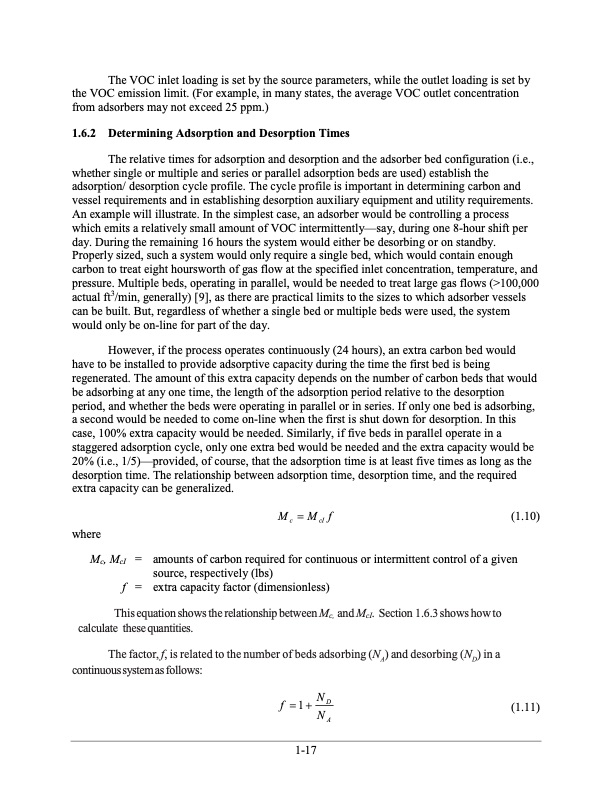
PDF Publication Title:
Text from PDF Page: 021
The VOC inlet loading is set by the source parameters, while the outlet loading is set by the VOC emission limit. (For example, in many states, the average VOC outlet concentration from adsorbers may not exceed 25 ppm.) 1.6.2 Determining Adsorption and Desorption Times The relative times for adsorption and desorption and the adsorber bed configuration (i.e., whether single or multiple and series or parallel adsorption beds are used) establish the adsorption/ desorption cycle profile. The cycle profile is important in determining carbon and vessel requirements and in establishing desorption auxiliary equipment and utility requirements. An example will illustrate. In the simplest case, an adsorber would be controlling a process which emits a relatively small amount of VOC intermittently—say, during one 8-hour shift per day. During the remaining 16 hours the system would either be desorbing or on standby. Properly sized, such a system would only require a single bed, which would contain enough carbon to treat eight hoursworth of gas flow at the specified inlet concentration, temperature, and pressure. Multiple beds, operating in parallel, would be needed to treat large gas flows (>100,000 actual ft3/min, generally) [9], as there are practical limits to the sizes to which adsorber vessels can be built. But, regardless of whether a single bed or multiple beds were used, the system would only be on-line for part of the day. However, if the process operates continuously (24 hours), an extra carbon bed would have to be installed to provide adsorptive capacity during the time the first bed is being regenerated. The amount of this extra capacity depends on the number of carbon beds that would be adsorbing at any one time, the length of the adsorption period relative to the desorption period, and whether the beds were operating in parallel or in series. If only one bed is adsorbing, a second would be needed to come on-line when the first is shut down for desorption. In this case, 100% extra capacity would be needed. Similarly, if five beds in parallel operate in a staggered adsorption cycle, only one extra bed would be needed and the extra capacity would be 20% (i.e., 1/5)—provided, of course, that the adsorption time is at least five times as long as the desorption time. The relationship between adsorption time, desorption time, and the required extra capacity can be generalized. Mc McI f (1.10) where Mc, McI = amounts of carbon required for continuous or intermittent control of a given source, respectively (lbs) f = extra capacity factor (dimensionless) ThisequationshowstherelationshipbetweenMc, andMcI. Section1.6.3showshowto calculate thesequantities. The factor, f, is related to the number of beds adsorbing (NA) and desorbing (ND) in a continuous system as follows: f1ND NA (1.11) 1-17PDF Image | Carbon Adsorbers

PDF Search Title:
Carbon AdsorbersOriginal File Name Searched:
final_carbonadsorberschapter_7thedition.pdfDIY PDF Search: Google It | Yahoo | Bing
CO2 Organic Rankine Cycle Experimenter Platform The supercritical CO2 phase change system is both a heat pump and organic rankine cycle which can be used for those purposes and as a supercritical extractor for advanced subcritical and supercritical extraction technology. Uses include producing nanoparticles, precious metal CO2 extraction, lithium battery recycling, and other applications... More Info
Heat Pumps CO2 ORC Heat Pump System Platform More Info
| CONTACT TEL: 608-238-6001 Email: greg@infinityturbine.com | RSS | AMP |